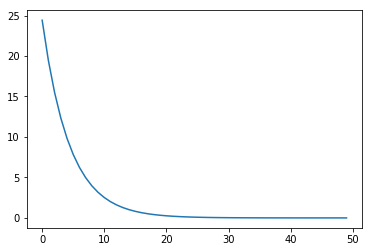@zsh-o
2019-05-29T13:20:29.000000Z
字数 5825
阅读 1313
‘梯度下降法’解‘不适定问题’引发的血案
日记
%matplotlib inlinefrom matplotlib import pyplot as pltimport numpy as npimport torchtorch.manual_seed(1234)
<torch._C.Generator at 0x7f5bc2eaa670>
原始代码
true_w = torch.tensor([2, -3.4]).view(-1, 1)true_b = torch.tensor([4.2]).view(-1, 1)
def get_fake_data():X = torch.linspace(1, 100, 100).view(50, 2)y = torch.mm(X, true_w) + true_b + 0.1 * torch.randn(50,1)return X, y
X, y = get_fake_data()
lr = 0.1epochs = 50
# NN weightsw = torch.randn(2, 1).requires_grad_(True)b = torch.randn(1, 1).requires_grad_(True)
def train(epoch):y_out = torch.mm(X, w) + bloss = 0.5 * (y - y_out) ** 2loss = loss.mean()# BPloss.backward()w.data.sub_(lr * w.grad.data)b.data.sub_(lr * b.grad.data)# clear gradw.grad.data.zero_()b.grad.data.zero_()il = loss.detach().item()print('[{:>3}/{}]: {:.5f}'.format(epoch, epochs, il))return il
L = []for epoch in range(1, epochs + 1):il = train(epoch)L.append(il)
[ 1/50]: 1476.52271
[ 2/50]: 674247936.00000
[ 3/50]: 307899192573952.00000
[ 4/50]: 140603937274971815936.00000
[ 5/50]: 64207568262302781027647488.00000
[ 6/50]: 29320750065869307107970023161856.00000
[ 7/50]: inf
[ 8/50]: inf
[ 9/50]: inf
[ 10/50]: inf
[ 11/50]: inf
[ 12/50]: inf
[ 13/50]: inf
[ 14/50]: inf
[ 15/50]: inf
[ 16/50]: nan
[ 17/50]: nan
[ 18/50]: nan
[ 19/50]: nan
[ 20/50]: nan
[ 21/50]: nan
[ 22/50]: nan
[ 23/50]: nan
[ 24/50]: nan
[ 25/50]: nan
[ 26/50]: nan
[ 27/50]: nan
[ 28/50]: nan
[ 29/50]: nan
[ 30/50]: nan
[ 31/50]: nan
[ 32/50]: nan
[ 33/50]: nan
[ 34/50]: nan
[ 35/50]: nan
[ 36/50]: nan
[ 37/50]: nan
[ 38/50]: nan
[ 39/50]: nan
[ 40/50]: nan
[ 41/50]: nan
[ 42/50]: nan
[ 43/50]: nan
[ 44/50]: nan
[ 45/50]: nan
[ 46/50]: nan
[ 47/50]: nan
[ 48/50]: nan
[ 49/50]: nan
[ 50/50]: nan
plt.plot(L)
[<matplotlib.lines.Line2D at 0x7f5b0584a1d0>]

print('W: \n{}'.format(w.detach().numpy()))print('b: \n{}'.format(b.detach().numpy()))
W:
[[nan]
[nan]]
b:
[[nan]]
调整学习速率
# NN weightstorch.manual_seed(1234)w = torch.randn(2, 1).requires_grad_(True)b = torch.randn(1, 1).requires_grad_(True)
lr = 1e-4
L = []for epoch in range(1, epochs + 1):il = train(epoch)L.append(il)
[ 1/50]: 5568.02197
[ 2/50]: 582.35992
[ 3/50]: 61.44717
[ 4/50]: 7.02108
[ 5/50]: 1.33448
[ 6/50]: 0.74029
[ 7/50]: 0.67816
[ 8/50]: 0.67163
[ 9/50]: 0.67090
[ 10/50]: 0.67078
[ 11/50]: 0.67072
[ 12/50]: 0.67067
[ 13/50]: 0.67062
[ 14/50]: 0.67057
[ 15/50]: 0.67053
[ 16/50]: 0.67048
[ 17/50]: 0.67043
[ 18/50]: 0.67038
[ 19/50]: 0.67033
[ 20/50]: 0.67028
[ 21/50]: 0.67023
[ 22/50]: 0.67018
[ 23/50]: 0.67013
[ 24/50]: 0.67008
[ 25/50]: 0.67003
[ 26/50]: 0.66998
[ 27/50]: 0.66993
[ 28/50]: 0.66988
[ 29/50]: 0.66984
[ 30/50]: 0.66979
[ 31/50]: 0.66974
[ 32/50]: 0.66969
[ 33/50]: 0.66964
[ 34/50]: 0.66959
[ 35/50]: 0.66954
[ 36/50]: 0.66949
[ 37/50]: 0.66944
[ 38/50]: 0.66939
[ 39/50]: 0.66934
[ 40/50]: 0.66930
[ 41/50]: 0.66925
[ 42/50]: 0.66920
[ 43/50]: 0.66915
[ 44/50]: 0.66910
[ 45/50]: 0.66905
[ 46/50]: 0.66900
[ 47/50]: 0.66895
[ 48/50]: 0.66890
[ 49/50]: 0.66885
[ 50/50]: 0.66880
plt.plot(L)
[<matplotlib.lines.Line2D at 0x7f5b057e6860>]

print('W: \n{}'.format(w.detach().numpy()))print('b: \n{}'.format(b.detach().numpy()))
W:
[[-0.85548615]
[-0.5098877 ]]
b:
[[-1.0222034]]
归一化
# NN weightstorch.manual_seed(1234)w = torch.randn(2, 1).requires_grad_(True)b = torch.randn(1, 1).requires_grad_(True)
def get_fake_data():X = torch.linspace(1, 100, 100).view(50, 2)X = (X - X.mean(dim=0, keepdim=True)) / X.std(dim=0, keepdim=True)y = torch.mm(X, true_w) + true_b + 0.1 * torch.randn(50,1)return X, y
X, y = get_fake_data()
lr = 1e-1
L = []for epoch in range(1, epochs + 1):il = train(epoch)L.append(il)
[ 1/50]: 15.20759
[ 2/50]: 12.04960
[ 3/50]: 9.58689
[ 4/50]: 7.65367
[ 5/50]: 6.12758
[ 6/50]: 4.91717
[ 7/50]: 3.95337
[ 8/50]: 3.18344
[ 9/50]: 2.56676
[ 10/50]: 2.07173
[ 11/50]: 1.67367
[ 12/50]: 1.35311
[ 13/50]: 1.09467
[ 14/50]: 0.88612
[ 15/50]: 0.71770
[ 16/50]: 0.58161
[ 17/50]: 0.47159
[ 18/50]: 0.38261
[ 19/50]: 0.31063
[ 20/50]: 0.25237
[ 21/50]: 0.20523
[ 22/50]: 0.16706
[ 23/50]: 0.13617
[ 24/50]: 0.11115
[ 25/50]: 0.09089
[ 26/50]: 0.07449
[ 27/50]: 0.06120
[ 28/50]: 0.05044
[ 29/50]: 0.04173
[ 30/50]: 0.03467
[ 31/50]: 0.02895
[ 32/50]: 0.02432
[ 33/50]: 0.02058
[ 34/50]: 0.01754
[ 35/50]: 0.01508
[ 36/50]: 0.01309
[ 37/50]: 0.01147
[ 38/50]: 0.01016
[ 39/50]: 0.00910
[ 40/50]: 0.00825
[ 41/50]: 0.00755
[ 42/50]: 0.00699
[ 43/50]: 0.00653
[ 44/50]: 0.00616
[ 45/50]: 0.00587
[ 46/50]: 0.00562
[ 47/50]: 0.00543
[ 48/50]: 0.00527
[ 49/50]: 0.00514
[ 50/50]: 0.00504
plt.plot(L)
[<matplotlib.lines.Line2D at 0x7f5b05749978>]

print('W: \n{}'.format(w.detach().numpy()))print('b: \n{}'.format(b.detach().numpy()))
W:
[[-0.8705319]
[-0.5142595]]
b:
[[4.168556]]
随机化X
# NN weightstorch.manual_seed(1234)w = torch.randn(2, 1).requires_grad_(True)b = torch.randn(1, 1).requires_grad_(True)
def get_fake_data():X = torch.randn(50, 2)y = torch.mm(X, true_w) + true_b + 0.1 * torch.randn(50,1)return X, y
X, y = get_fake_data()
lr = 1e-1
L = []for epoch in range(1, epochs + 1):il = train(epoch)L.append(il)
[ 1/50]: 24.41483
[ 2/50]: 19.44870
[ 3/50]: 15.49367
[ 4/50]: 12.34376
[ 5/50]: 9.83496
[ 6/50]: 7.83671
[ 7/50]: 6.24504
[ 8/50]: 4.97715
[ 9/50]: 3.96713
[ 10/50]: 3.16249
[ 11/50]: 2.52144
[ 12/50]: 2.01068
[ 13/50]: 1.60371
[ 14/50]: 1.27942
[ 15/50]: 1.02099
[ 16/50]: 0.81504
[ 17/50]: 0.65089
[ 18/50]: 0.52005
[ 19/50]: 0.41575
[ 20/50]: 0.33260
[ 21/50]: 0.26631
[ 22/50]: 0.21345
[ 23/50]: 0.17130
[ 24/50]: 0.13768
[ 25/50]: 0.11087
[ 26/50]: 0.08948
[ 27/50]: 0.07241
[ 28/50]: 0.05880
[ 29/50]: 0.04793
[ 30/50]: 0.03926
[ 31/50]: 0.03233
[ 32/50]: 0.02681
[ 33/50]: 0.02239
[ 34/50]: 0.01887
[ 35/50]: 0.01605
[ 36/50]: 0.01380
[ 37/50]: 0.01200
[ 38/50]: 0.01057
[ 39/50]: 0.00942
[ 40/50]: 0.00850
[ 41/50]: 0.00776
[ 42/50]: 0.00718
[ 43/50]: 0.00670
[ 44/50]: 0.00633
[ 45/50]: 0.00603
[ 46/50]: 0.00578
[ 47/50]: 0.00559
[ 48/50]: 0.00543
[ 49/50]: 0.00531
[ 50/50]: 0.00521
plt.plot(L)
[<matplotlib.lines.Line2D at 0x7f5b057351d0>]

print('W: \n{}'.format(w.detach().numpy()))print('b: \n{}'.format(b.detach().numpy()))
W:
[[ 2.0044322]
[-3.4053428]]
b:
[[4.1659384]]
广义逆
def get_fake_data():X = torch.linspace(1, 100, 100).view(50, 2)y = torch.mm(X, true_w) + true_b + 0.1 * torch.randn(50,1)return X, y
X, y = get_fake_data()y = y - 4.2 # 不考虑b
X.shape, y.shape, w.shape
(torch.Size([50, 2]), torch.Size([50, 1]), torch.Size([2, 1]))
X_T = X.transpose(0, 1)G_X = torch.mm(X_T, X)w = torch.mm(torch.inverse(G_X), torch.mm(X_T, y))
print('W: \n{}'.format(w.detach().numpy()))
W:
[[ 1.9667375]
[-3.3663373]]
分析特征值
X = (X - X.mean(dim=0, keepdim=True)) / X.std(dim=0, keepdim=True)
X_T = X.transpose(0, 1)G_X = torch.mm(X_T, X)
u, s, v = torch.svd(G_X)
s
tensor([9.8000e+01, 1.6248e-08])
